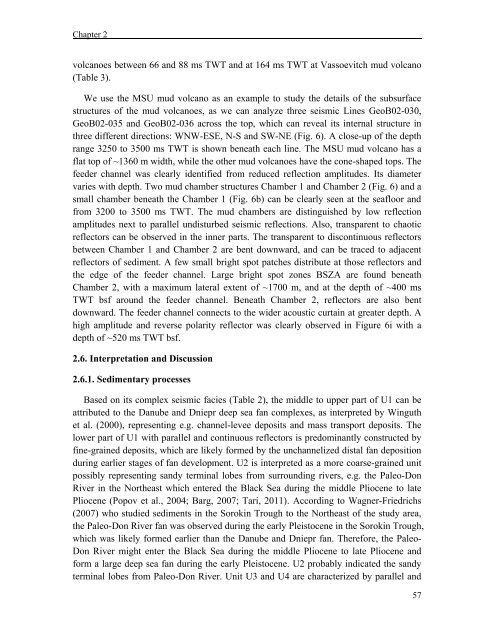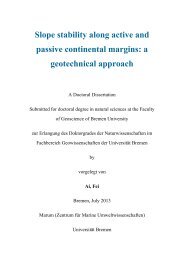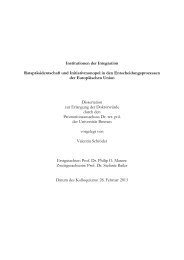Seismoacoustic Study of the Shallow Gas Transport and ... - E-LIB
Seismoacoustic Study of the Shallow Gas Transport and ... - E-LIB
Seismoacoustic Study of the Shallow Gas Transport and ... - E-LIB
Create successful ePaper yourself
Turn your PDF publications into a flip-book with our unique Google optimized e-Paper software.
Chapter 2<br />
volcanoes between 66 <strong>and</strong> 88 ms TWT <strong>and</strong> at 164 ms TWT at Vassoevitch mud volcano<br />
(Table 3).<br />
We use <strong>the</strong> MSU mud volcano as an example to study <strong>the</strong> details <strong>of</strong> <strong>the</strong> subsurface<br />
structures <strong>of</strong> <strong>the</strong> mud volcanoes, as we can analyze three seismic Lines GeoB02-030,<br />
GeoB02-035 <strong>and</strong> GeoB02-036 across <strong>the</strong> top, which can reveal its internal structure in<br />
three different directions: WNW-ESE, N-S <strong>and</strong> SW-NE (Fig. 6). A close-up <strong>of</strong> <strong>the</strong> depth<br />
range 3250 to 3500 ms TWT is shown beneath each line. The MSU mud volcano has a<br />
flat top <strong>of</strong> ~1360 m width, while <strong>the</strong> o<strong>the</strong>r mud volcanoes have <strong>the</strong> cone-shaped tops. The<br />
feeder channel was clearly identified from reduced reflection amplitudes. Its diameter<br />
varies with depth. Two mud chamber structures Chamber 1 <strong>and</strong> Chamber 2 (Fig. 6) <strong>and</strong> a<br />
small chamber beneath <strong>the</strong> Chamber 1 (Fig. 6b) can be clearly seen at <strong>the</strong> seafloor <strong>and</strong><br />
from 3200 to 3500 ms TWT. The mud chambers are distinguished by low reflection<br />
amplitudes next to parallel undisturbed seismic reflections. Also, transparent to chaotic<br />
reflectors can be observed in <strong>the</strong> inner parts. The transparent to discontinuous reflectors<br />
between Chamber 1 <strong>and</strong> Chamber 2 are bent downward, <strong>and</strong> can be traced to adjacent<br />
reflectors <strong>of</strong> sediment. A few small bright spot patches distribute at those reflectors <strong>and</strong><br />
<strong>the</strong> edge <strong>of</strong> <strong>the</strong> feeder channel. Large bright spot zones BSZA are found beneath<br />
Chamber 2, with a maximum lateral extent <strong>of</strong> ~1700 m, <strong>and</strong> at <strong>the</strong> depth <strong>of</strong> ~400 ms<br />
TWT bsf around <strong>the</strong> feeder channel. Beneath Chamber 2, reflectors are also bent<br />
downward. The feeder channel connects to <strong>the</strong> wider acoustic curtain at greater depth. A<br />
high amplitude <strong>and</strong> reverse polarity reflector was clearly observed in Figure 6i with a<br />
depth <strong>of</strong> ~520 ms TWT bsf.<br />
2.6. Interpretation <strong>and</strong> Discussion<br />
2.6.1. Sedimentary processes<br />
Based on its complex seismic facies (Table 2), <strong>the</strong> middle to upper part <strong>of</strong> U1 can be<br />
attributed to <strong>the</strong> Danube <strong>and</strong> Dniepr deep sea fan complexes, as interpreted by Winguth<br />
et al. (2000), representing e.g. channel-levee deposits <strong>and</strong> mass transport deposits. The<br />
lower part <strong>of</strong> U1 with parallel <strong>and</strong> continuous reflectors is predominantly constructed by<br />
fine-grained deposits, which are likely formed by <strong>the</strong> unchannelized distal fan deposition<br />
during earlier stages <strong>of</strong> fan development. U2 is interpreted as a more coarse-grained unit<br />
possibly representing s<strong>and</strong>y terminal lobes from surrounding rivers, e.g. <strong>the</strong> Paleo-Don<br />
River in <strong>the</strong> Nor<strong>the</strong>ast which entered <strong>the</strong> Black Sea during <strong>the</strong> middle Pliocene to late<br />
Pliocene (Popov et al., 2004; Barg, 2007; Tari, 2011). According to Wagner-Friedrichs<br />
(2007) who studied sediments in <strong>the</strong> Sorokin Trough to <strong>the</strong> Nor<strong>the</strong>ast <strong>of</strong> <strong>the</strong> study area,<br />
<strong>the</strong> Paleo-Don River fan was observed during <strong>the</strong> early Pleistocene in <strong>the</strong> Sorokin Trough,<br />
which was likely formed earlier than <strong>the</strong> Danube <strong>and</strong> Dniepr fan. Therefore, <strong>the</strong> Paleo-<br />
Don River might enter <strong>the</strong> Black Sea during <strong>the</strong> middle Pliocene to late Pliocene <strong>and</strong><br />
form a large deep sea fan during <strong>the</strong> early Pleistocene. U2 probably indicated <strong>the</strong> s<strong>and</strong>y<br />
terminal lobes from Paleo-Don River. Unit U3 <strong>and</strong> U4 are characterized by parallel <strong>and</strong><br />
57
















